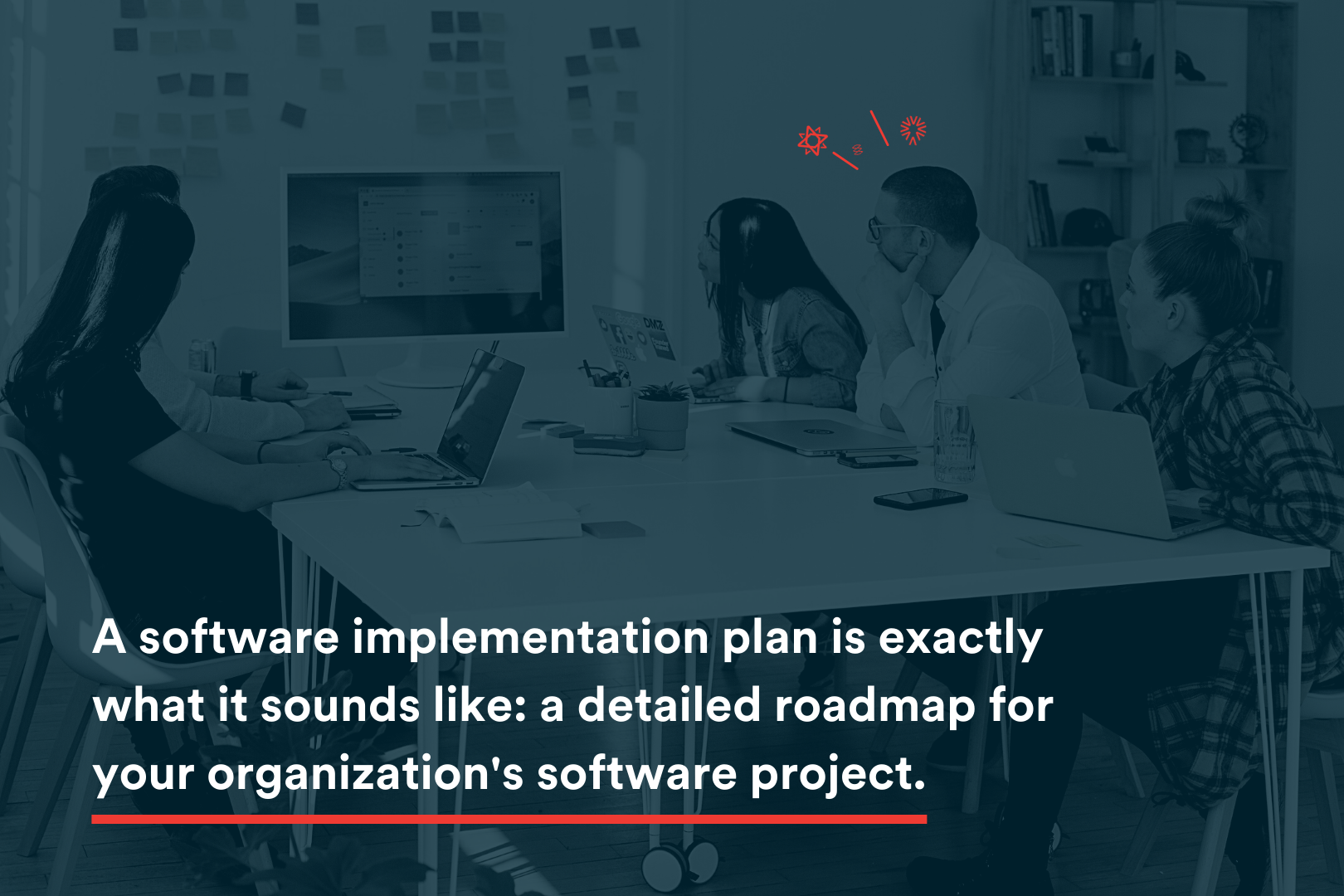software development | agile | product development
"Human nature is to need a map. If you’re brave enough to draw one, people will follow." — Seth Godin
Wise words from author and business executive Seth Godin. In the daunting context of implementing a new system or software for your business, his words ring even truer — a solid roadmap ensures things run as smoothly as possible throughout the process. We’ve curated a quick and handy guide to help you gain a handle on how to approach software implementation planning.
What We’ll Cover
- What a software implementation plan actually is and why you need one
- Why the Agile methodology is crucial to long-term success
Let's get started.
What is a Software Implementation Plan? (Plus, Why You Need One)
A software implementation plan is exactly what it sounds like: a detailed roadmap for your organization’s software project. It documents every step needed to turn your plan from idea into reality, with clear objectives, goals, assigned stakeholders, and a timeline for each phase.
Having an in-depth implementation plan for your software project is crucial to your success for a variety of reasons:
- It helps you and your team stay on track, making it easier to complete tasks, distribute work, and meet or shift deadlines as needed.
- It improves communication and cooperation, from the development team to project management and any additional key stakeholders or third parties.
- A thorough, detailed plan makes getting buy-in a breeze — through every phase and milestone of the project.
Now that we’ve covered the what and why, let’s dig deeper into the how of software implementation planning.

Why An Agile Software Implementation Plan is the Right Fit
We’ve found that the best approach to a successful product development initiative is to use an agile methodology. At Aviture, we use Scrum as our default agile framework. There are other options that may fit your organization’s way of working more closely than Scrum, but if you’re new to Agile, we definitely recommend starting here, as it’s a great method of setting the stage for a successful project roadmap.
The traditional approach to development uses something known as a waterfall model. In this framework, you’d outline your project, along with all goals and milestones, right from the start. Unfortunately, this plan can often prove inflexible, not accounting for roadblocks that may arise over the course of discovery and implementation.
The Agile approach, on the other hand, provides a tighter timeline, with project sprints occupying your team for a series of shorter periods, enabling you to adjust at the end of each. Two- or four-week sprints are common, but it really depends on your environment. You want to make the cycles as tight as you can so that you can deliver value at a high degree of frequency, which invites real-time, actionable feedback.
In this structure, you have your long-term goal set, but you give yourself the leeway to adjust assignments and individual and team milestones as necessary to best suit the implementation plan as it progresses.
Agile enables you to develop software solutions through collaboration and cross-functional teams that best serve the end user — and, most importantly, it ensures the most intelligent solution for continuous growth.
.png?width=1620&name=In%20Blog%20Image%20-%20A%20software%20implementation%20plan%20is%20exactly%20what%20it%20sounds%20like%20a%20detailed%20roadmap%20for%20your%20organizations%20software%20project.%20(2).png)
Still not sure of the difference? Let’s stick with the map analogy for a second. Imagine you’re traveling from New York to Los Angeles, which Google tells us takes about 41 hours of driving time. Using the traditional albeit dated waterfall approach, you would map out your route ahead of time, setting waypoints along the route, areas to gas up, the exact road you’re going to take, where you’re going to eat, who’s going to drive each leg, where you’re going to stay overnight, etc.
That’s the waterfall approach. You have your goal and deploy the best plan to meet the goal at the outset.
With Agile methodology, you can account for deviations along the way. Making it to Los Angeles from New York is still the goal, but you give yourself the opportunity to pivot as necessary depending on how the project (in this case, a cross-country drive) is going.
You hit construction, so you need to find a new route. That’s okay, let’s set a new course that gets us there on time. Hotel at full occupancy? Let’s drive another hour or two to stay on track. Let’s get to Chicago within 12 hours, then see how we’re feeling before deciding if we can push forward or find a hotel. Are we ahead of schedule? Great, let’s find some roadside attractions to visit to make this an even better journey. Inclement weather? That’s okay, let’s push the timetable and adjust accordingly.
Sometimes, the ultimate destination may even change as you pursue your project! Maybe halfway through your trip, you hear there’s a wildfire affecting your vacation destination, so you decide to go elsewhere entirely.
How does this apply to business? Well, your situation may change or you may realize that what your customers are asking for in a product is different from what they actually want, with those requests serving as symptoms of an underlying issue you’ll need to pivot to address. This could mean a user experience that’s completely different from what you initially assumed, or a whole new software solution. The key is adapting to change, not fighting it based on preconceived notions of what your project should be.
Agile is about a continuous delivery of business value. By delivering incremental results over the course of the project (through various sprints), users have something to engage with at all times and can provide feedback early and often. This provides stakeholders the opportunity to share their input, particularly from a non-technical perspective. It’s these viewpoints that allow your team to home in on the most impactful end-solution for clients.
You Know What It Is…Now It’s Time to Execute
Software implementation planning can be a daunting process, but it’s made easier by understanding what it is you’re doing and the steps you’ll take to get there. An Agile framework that allows you to alter your path, your timeline, or even your destination can provide the flexible framework needed to bring you success in record time.
Need help turning your vision into a reality? Contact Aviture. We’ll work closely with your organization to uncover your vision and define the best path to take you there.





